Are you tired of seeing the password change notifications? Are you unsure how to remove the notifications? In this tutorial you’ll learn how.
Managing your WordPress site can be a breeze, but dealing with an overflowing inbox full of password change notifications is not only annoying, but it can also hinder the efficient operation of your website.
Fortunately, there’s a simple solution.
In this article, we will guide you through the process of turning off password change notifications in WordPress to reduce email clutter and enhance your website security.
First, let’s talk about the benefits of turning off the password change notifications.
Benefits Of Turning Off Password Change Notifications



Turning off password change notifications in WordPress can has two main benefits. They help keep your reduce email clutter and improve the security of your website. Let’s cover each of these two benefits in depth.
Reduced Email Clutter
Reducing email clutter is one of the main benefits of turning off password change notifications in WordPress. With so many important emails arriving daily for your website, it’s essential to keep your inbox clean and organized.
By turning off these unnecessary notifications, you’ll be able to focus on the messages that truly matter for your business and avoid clutter.
Improved Website Security
Disabling password change notifications in WordPress can greatly improve website security. When hackers attempt to gain access to a user’s account by guessing their password, the user will often receive an email notification of a failed login attempt or a successful login from an unfamiliar device.
By disabling these notifications, hackers are less likely to be detected and stopped before they cause any damage.
Even if you aren’t bothered by the password change notifications, disabling is recommended to improve your site’s security.
Disabling Password Change or Reset Notifications in WordPress
You can disable password change or reset notifications in WordPress by using a plugin using or adding code to disable notifications through the filter hook called send_password_change_email.
Let’s now cover each of these methods step by step.
Using The WP Mail SMPT Plugin
This is the simplest method for turning disabling the password change notifications.
You will need the pro version of the WP Mail SMPT plugin to disable the password notifications.

Once you have the plugin installed, go to WP Mail SMPT > Settings in your WordPress dashboard. Next, click on the Email Controls tab on the settings page.

Locate the Password Reset Successfully section and turn the slider off.
That’s it! The password notifications will now be deactivated for your website.
Now let’s cover the second method which will allow you to disable the notifications for all users on your website.
Adding Code To Disable Notifications
First, you need to access your WordPress files using an FTP client, your hosting account’s file manager, or going to Appearance > Theme File Editor in your WordPress dashboard.
In this tutorial, we’ll access the WordPress files from the Theme File Editor.
Regardless of the method you choose to access your WordPress files, you’ll want to navigate to your theme’s functions.php file. If you are using an FTP client or using a file manager, it will be in wp-content/themes/your-theme-name.

When you access your website’s files from the WP dashboard, the functions.php file will be in the left hand side of the Theme File Editor page.
Next, open the functions.php file for editing and insert the following lines of PHP code at the end of the file:
1 |
if ( !function_exists( 'wp_password_change_notification' ) ) {
|
2 |
function wp_password_change_notification() {}
|
3 |
} |
This will disable both user and admin password change email notifications.


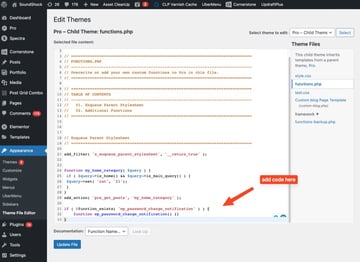
Next, save your changes to the functions.php file or if you are in the WordPress dashboard, click the Update File button.
Finally, test to see if this works by executing a password reset action on your WordPress site to ensure that no email notifications are sent.
Remember to use caution when editing your theme’s files directly, as any mistakes could result in a broken website. Always back up your site before making code modifications, and consider using a child theme for customizations to avoid issues during future theme updates.
By incorporating these steps into your WordPress configuration, you can effectively disable password change email notifications for both users and administrators, helping improve website security, reduce email clutter, and enhance user account management efficiency.
Discover Top WordPress Resources
Still learning how to use WordPress? Check out the following resources as they cover some common problems and issues that WordPress site owners often encounter.
Disable Password Change Notifications Now!
Disabling password change notifications in WordPress is quick and easy. You can do it either by installing the WP Mail SMTP Plugin or using code to disable all the email notifications on your site.
You’ll not only reduce email clutter, but also tighten security on your website by disabling these notifications.
Looking to add new features to your WordPress website. Envato Elements gives you access to a library full of themes, plugins, and thousands of other creative assets. Don’t miss out on this great resource that all WordPress site owners can take advantage of.